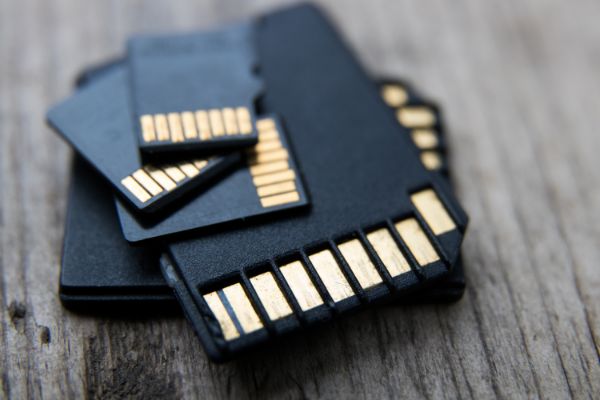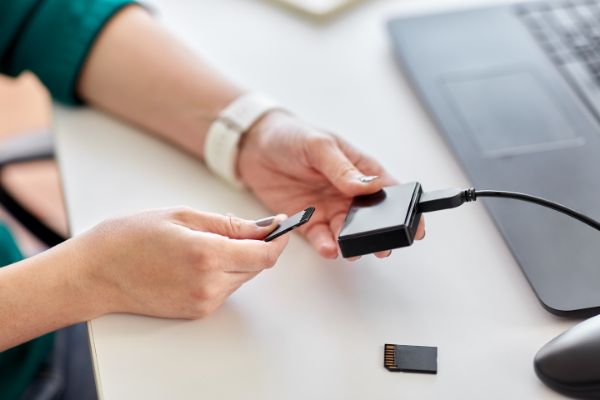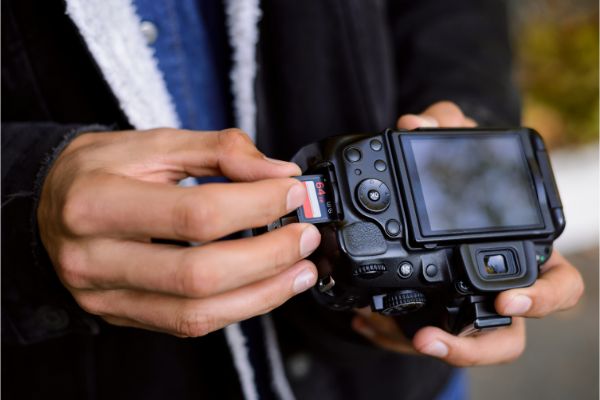Disclaimer: This post may contain affiliate links, meaning we get a small commission if you make a purchase through our links, at no cost to you. For more information, please visit our Disclaimer Page.
Secure Digital (SD) cards are among the more commonly used memory and storage cards. First released in the 1990s, this card is still used by many today. Find out more about these cards and why some users think they are so unreliable.
Table of Contents
Are SD Cards Fragile?
An SD card is a small memory card with a plastic case and chips along the back. When you place one on your computer, it reads the data on the card and lets you view, open, edit, and delete the files.
Many brands give you a plastic case that helps you store the card safely. There are also SD card wallets. They are larger plastic cases with individual slots to help you store multiple cards. They even have spaces on the top to write identifying info.
Looking at SD card cases and wallets might make you think that they are fragile. But SD cards are not. Some cards got left in pockets and into the washing machine but still worked once they dried out. Other SD cards got dropped in puddles but are still usable.
But not all SD cards are the same. Certain factors and conditions can shorten the life of your SD card and even corrupt it.
Why Do SD Cards Corrupt So Easily? 8 Causes
You might have an old SD card lying in your drawer, but it’s likely that the card will not work. Try reading the card on your computer or with an adapter and see if you can access the files. If you cannot, check out some of the causes of SD card corruption.
1. Physical Damage
Physical damage is one of the more common causes of corruption. SD cards are so thin and light that improper storage can damage them. Heavy objects placed on top can bend or even break the card.
Carrying the card in your pocket is just as dangerous. Putting it in your bag or backpack can corrupt your SD card. Moisture can also lead to corruption. This includes dropping the card in a snowbank or a glass of water and accidentally spilling water or soda on it.
2. Defects
You might assume that you need to format a new SD card because you can use it right out of the package. But formatting it ensures that it doesn’t have any defects that will affect your data.
Cheaper SD cards are more prone to defects than their more expensive counterparts. While some defects occur during the manufacturing process, others happen during shipment. SD cards can even have bad sectors right out of the package.
3. Operating System Corruption
When you view data from your SD card on your computer, you need to use your Operating System (OS) to access it. There is a small chance that your OS might malfunction in the middle of the process and corrupt some or all of your data.
This can occur when the power goes out when you’re on your computer or when the hard drive fails. Malfunctions can also include a system restart. If you have the SD card opening and working on a file when your computer restarts, it can corrupt the card and the file.
4. Cycle Failures
One of the best things about SD cards is that you can cycle through them. You don’t need to keep the same data on the card for years or keep deleting files and folders every few weeks. Formatting and reformatting the cards remove unnecessary data. It also frees up storage space.
Note that SD cards can only go through those cycles a certain number of times. It can slow down the formatting process or that it brings up an error message when you try to format it. These are signs that the SD card has enough corruption that it’s near the end of its life.
5. Bad Sectors
Also known as a bad block, a bad sector is a spot on the SD card that has an error. It stops the card from using it for storage. All it takes is one bad sector for a serious problem to occur. That block will limit the amount of storage space you have. It can also spread and create more bad sectors that eventually take over the whole card.
6. Extreme Temperatures
You should always be cautious about how you store an SD card. Extreme temperatures can cause corruption. Most brands recommend that you keep the cards at a temperature range of -13 to 185 degrees Fahrenheit.
You won’t have such extreme temperatures inside your house. Keep in mind, though, that outdoor temperatures are much higher. If you store the card in your bag in the trunk of your car, it can get so hot and damage the card. The same thing can happen when you expose your card to cold temperatures.
7. Improper Removal
Most systems that read SD cards have a process you need to follow. Generally, you can insert the card right into a slot on your PC. But you may need to open your Utilities and turn off the card before removing it.
You need to follow similar steps when it comes to using the card on other devices, such as a camera. In most cases, you need to turn the camera off before you remove the card. Improper removal of the card can lead to corruption.
8. Malware
If you use an SD card on your computer, you risk catching malware that will cause it to malfunction. It’s easy to pick up malware from some of the websites you visit. But it’s more common when you download games or videos.
Also, use caution when clicking links in your emails. Malware, as well as viruses, can corrupt the SD card and prevent you from recovering any of the data stored on it. Though it’s possible to remove the malware and recover some of the data, it depends on the type of malware.
Can I Retrieve Files from a Corrupted SD Card?
Don’t assume that you need to throw away a corrupted SD card. You can take the card to a professional and ask if they can retrieve your data. But it can cost you a lot of money to do this. Consider some of the best ways to retrieve files from a corrupted SD card on your own.
Signs of a Corrupted Card
Before you try any of these methods, make sure you have a corrupted card. One sign is that your device can no longer recognize it. Try removing the card and turning the device off. Insert the card and turn the device back on to see if it can find the card. If you need to get data off a corrupted SD card, try using it on a different device or system. You’ll find out if the problem is with the card or with the other device. Other signs of a corrupted SD card include:
- Your device claims you cannot edit, delete, or access files on the card.
- There are missing files on the card.
- You get a black screen when you try to open the SD card.
- The device says that you need to format the card before you can use it.
How to Retrieve Your Data
Data recovery software is one of the best ways to retrieve data from a damaged SD card. It’s similar to the software that professionals use. Once you download and install the software, insert your card and open the program.
Select the card from the listed storage devices and choose the option to find missing files. The software will scan every part of the card it can reach and give you a list of all the files found. You can then pick which ones you want to transfer to your hard drive.
Windows File Recovery can help in some cases. Any computer running Windows 10 or a Windows OS from 2004 or after will work with this software. You can download it from the Microsoft Store. Choose the location of the SD card and enter more info to run a search.
Windows File Recovery can be confusing for those who do not have a lot of experience with computers. You risk damaging your PC and causing other problems when you try to use it.
If you back up your system, you might find older versions of your missing files in other places. Always check your internal memory first.
Some devices store temporary copies of your most recent files that you can access for a few hours. Many devices now come with cloud storage that automatically backs up your files in the cloud. You just need to log into your account and look for them.
Using a disk checker tool is also helpful. Start your system and open My Computer. Find the SD card listed. It should appear near the bottom of your screen.
Right-click on the card and select the Properties option. Click on the Tools button and look for the Error Checking box. After clicking the Check button, your computer will go over the file. It will let you know if it found any errors and if there is any data on it.
How Do I Prevent My SD Cards from Getting Corrupted? 6 Tips
Learning how to prevent your SD cards from getting corrupted can save you from any hassles in the future. You don’t need to spend a few hours trying to recover all your lost data or waste a lot of money on professional help. Check out some of the top tips to keep your SD cards safe.
1. Use Them Often
SD cards are more susceptible to damage and corruption if you do not use them often. You should use your cards at least once a year. You don’t have to spend a lot of time working on them.
Checking out the files you saved on them and adding a new file is enough. Using the card on a regular basis helps you discover problems before they worsen. If you have a few cards that you use regularly, use them alternately.
2. Format New Cards
Never use an SD card unless you format it first, including brand-new ones you bought from a reputable store. It takes only minutes to format a card, and it can save you a lot of time later.
First, insert the card and right-click it to start formatting. Make sure the SD card is compatible with your device and has no harmful data or defects on it. Don’t forget to reformat your old SD cards, either. While some cards have a “Delete All” option, this can corrupt the card and leave files you don’t want behind.
3. Stick to One Card Per Device
Do you find yourself using the same SD card for several devices? Perhaps, you’re using it for two or more cameras as well as your computer. It’s a dangerous practice.
Removing it so often can corrupt the card. You also risk one of your devices deleting or writing over some of the files that another device saved. Each device should have its dedicated SD card.
4. Use the Eject
How many times have you pulled your SD card right out of your computer without thinking twice? If you’re doing this, stop.
In the same way that you need to remove a USB drive properly, you need to remove an SD card correctly. When you want to remove the card, use the eject feature. This stops your computer from using the card and closing any open files.
You can also turn your computer off before removing the card. Removing the card with your computer on can damage it. That’s because your PC may still have a few files open or is indexing the files.
5. Keep an Eye on Your Battery
When you use an SD card in your camera or another device, always keep an eye on your battery. It can damage or corrupt your card when your device suddenly shuts down. It will also stop saving data which can result in you losing data. It can also cause new files to write over existing files.
6. Use a Card Case
Card cases and wallets prevent SD card corruption. Most of the cards that are available today come with a small plastic case, just big enough to hold the card. Because of their size, you can easily lose or misplace them. The cases are also quite cheap and light, which won’t do much to protect your card.
An SD card wallet is a better alternative. It uses durable materials that keep the cards inside safe. Some wallets have enough room for 10 or more SD cards.
Conclusion
SD cards are so common today that you likely have a few that you use on all of your devices. Despite getting damaged easily, you can prevent that damage and make your cards last longer. Read other practical tips on how to protect your SD card.



